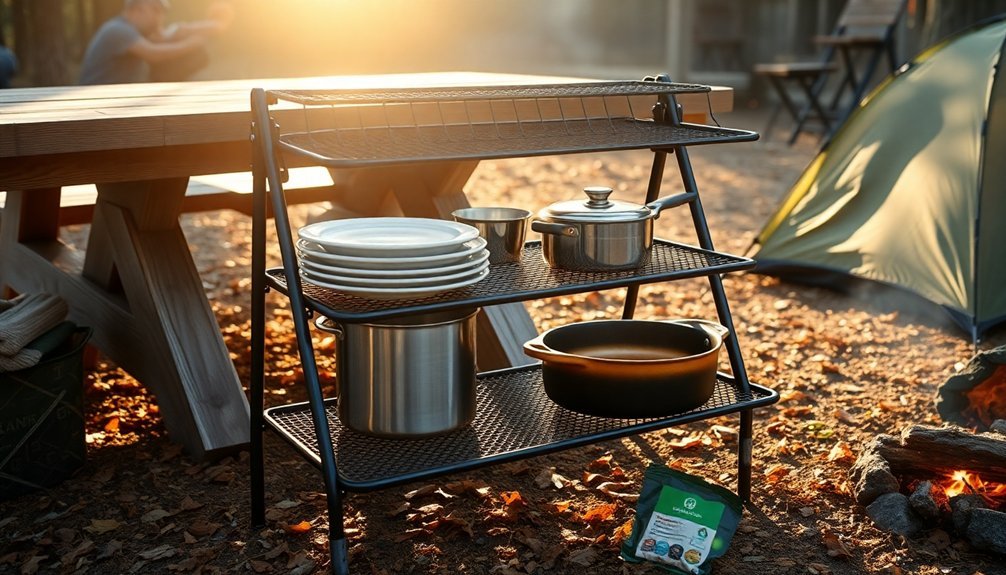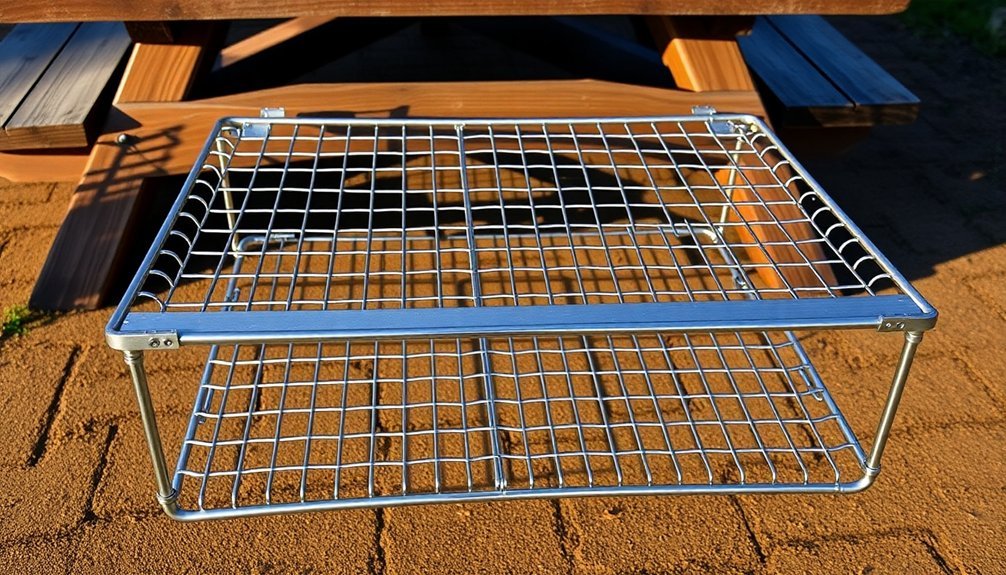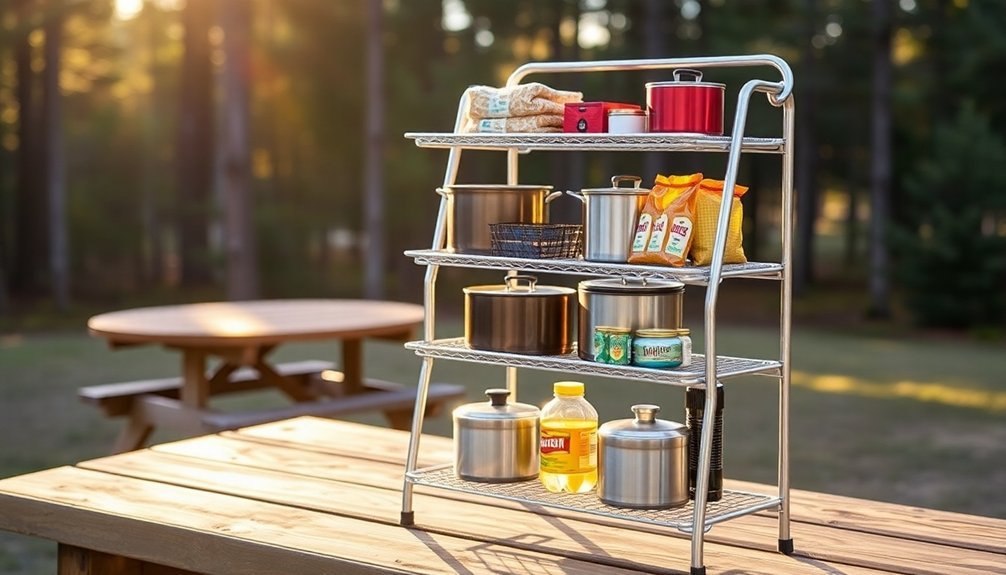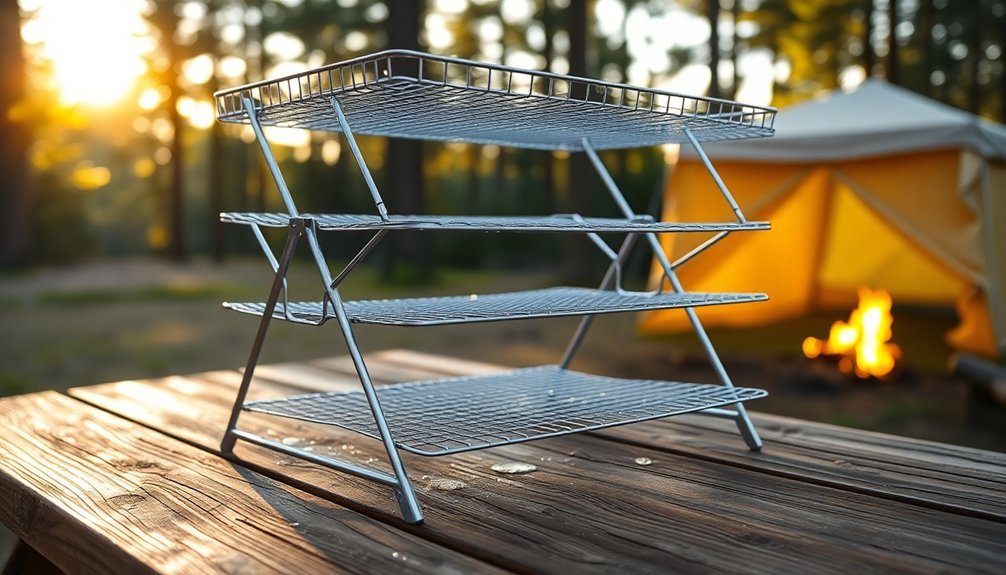You'll find the Komodo Camp Kitchen is your best bet for a foldable food rack while camping. This sturdy unit features aircraft-grade aluminum construction that won't rust or corrode, plus a smart three-tier design that maximizes vertical space. With a 55-pound weight capacity, you can store all your camping essentials without worry. The rack's adjustable legs handle uneven terrain, while its compact folding design makes transport and setup a breeze. Multiple compartments keep your food and gear organized, and the weather-resistant build guarantees your supplies stay protected. There's much more to discover about optimizing your camp kitchen setup.
Types of Camping Food Racks

Food organization during camping requires the right storage solution, and several types of camping food racks serve different purposes.
You'll find foldable camp pantries that offer lightweight, collapsible designs with multiple compartments for storing non-perishable items. A camp cupboard is ideal for storing bread, snacks, and shelf-stable foods. These portable units can be quickly set up near your campsite to keep food organized and within easy reach.
For your perishable items, you'll need portable coolers and eskies equipped with freezer blocks. These come in various sizes and sometimes include shelves and drainage plugs to help maintain freshness and organization.
If you're looking for versatile storage, plastic containers and bins offer stackable solutions that protect your food and kitchen gear while keeping your campsite tidy.
When camping in areas with wildlife, especially bears, you'll need wildlife-proof storage options. Bear canisters and bear bags are often mandatory in certain camping locations, and you can use them alongside your other storage methods.
These specialized containers protect both your food supply and local wildlife, ensuring a safer camping experience while complying with local regulations.
Design Features That Matter
When choosing a foldable food rack for camping, you'll want to focus on three critical design elements that make a real difference in the field.
You need smart storage solutions with multiple compartments and adjustable shelving to maximize space, along with stability features like adjustable legs and ground stakes that keep your setup secure on uneven terrain.
The frame material matters greatly too – look for aircraft-grade aluminum or stainless steel construction that offers durability without adding excessive weight to your camping gear. The Komodo Camp Kitchen exemplifies this with its compact 16-inch width design that makes transport and setup remarkably convenient.
Storage and Space Management
Smart storage solutions define the best foldable food racks, with design features that transform limited camping space into an organized outdoor kitchen.
You'll find a 3-tier storage system that maximizes vertical space while keeping your camping essentials neatly arranged. The tabletop supports up to 33 pounds, while individual shelves can hold 11 pounds each, giving you ample space for your cooking equipment and supplies.
The rack's thoughtful compartmentalization lets you separate your dishes, food items, and cooking utensils. You'll appreciate the additional side storage pockets, perfect for keeping smaller items like spices, utensils, or snacks within easy reach.
The zippered doors protect your supplies from insects and wildlife while providing quick access when you need it. The included premium oxford cloth ensures lasting durability and waterproof protection for your stored items.
The mesh design isn't just about durability – it offers clear visibility of your stored items and promotes air circulation to keep food fresh.
When you're organizing your camping kitchen, you can choose between standing setup or hanging options, depending on your campsite layout. The MDF tabletop provides a stable work surface that's easy to clean, making meal prep and cooking more efficient in the outdoors.
Stability Across Terrains
A stable foundation makes all the difference when you're setting up your outdoor kitchen, and this foldable food rack delivers with its terrain-adaptive design features. The adjustable legs with non-slip feet let you achieve perfect balance on uneven ground, while the wide base guarantees your cooking setup won't tip over during meal prep.
| Feature | Benefit |
|---|---|
| Telescoping Legs | Adapts to rocky or sloped terrain while maintaining a level surface |
| Low Center of Gravity | Prevents tipping even when loaded with cookware and supplies |
| Built-in Leveling System | Quick adjustments for perfect stability on any surface |
You'll appreciate the rack's weather-resistant design when conditions get challenging. The sturdy aluminum construction stands up to wind, while the included ground anchors provide extra security during gusty conditions. Setting up is a breeze with the tool-free assembly system – you'll have your cooking station ready in minutes. The lightweight yet robust frame distributes weight evenly across all support points, assuring your food and cooking gear stay secure. When you're done, the rack folds down compactly and slides into its included carry bag for easy transport to your next campsite.
Frame Material Selection
Durability meets innovation in the frame material selection of top-performing camping food racks. When you're choosing your camping food rack, you'll find three main material categories that each offer distinct advantages for your outdoor cooking setup.
Metal frames, particularly aluminum and steel, deliver the best balance of strength and portability. You'll appreciate aluminum's lightweight nature while still getting the stability you need for heavy cookware and food items. These frames won't rust easily and can handle rough weather conditions you'll encounter outdoors.
While wooden frames offer natural aesthetics and can be field-repaired, you'll need to take into account their heavier weight and ongoing maintenance requirements. If you're planning extended trips, wood mightn't be your best choice due to its vulnerability to moisture and weather damage.
For maximum versatility, think about hybrid material frames that combine aluminum supports with fabric and PVC components. You'll get the strength of metal where it counts, plus useful features like adjustable side tables and storage compartments.
These modern designs often include windshields and non-slip fasteners, making them particularly suitable for varied camping conditions.
Materials and Durability

Modern camping food racks combine cutting-edge materials to guarantee long-lasting performance in the outdoors.
You'll find that most high-quality racks use 600D Oxford Nylon, which provides exceptional water resistance and durability against rough handling and diverse weather conditions. This material's water-repellent coating adds an extra layer of protection for your camping gear.
The frame construction typically features heavy-duty materials like fiberglass or steel, ensuring your rack remains stable even when it's empty.
You'll appreciate how these materials work together to create a sturdy structure that won't wobble or collapse during use. The frames are engineered to support significant weight while maintaining their structural integrity throughout your camping adventure.
When you're looking at durability features, focus on the water-resistant construction and heavy-duty build.
You'll want a rack that can withstand unexpected rain showers and rough terrain. The best models offer protective elements that extend the shelf life of your food supplies while keeping them organized and accessible.
Plus, these durable materials don't compromise on weight – they're designed to be lightweight and fold flat for easy transport and storage when you're not using them.
Setting Up Your Drying Station
Setting up your drying station starts with proper frame assembly and screen installation. You'll need to construct two picture frames using 1-by-2-inch furring strips, securing them with coarse-thread drywall screws. Sandwich the chicken wire or fine mesh screen between the frames, ensuring it's pulled taut and properly stapled.
| Setup Component | Indoor Use | Outdoor Use |
|---|---|---|
| Frame Support | Books/blocks | Bricks/stones |
| Screen Type | Fine mesh | Heavy-duty wire |
| Elevation Height | 2-3 inches | 4-6 inches |
For ideal drying conditions, you'll need to elevate your rack using blocks, bricks, or books at each corner. This promotes air circulation and prevents moisture buildup. If you're using salvaged materials like old window screens, thoroughly clean them with hot soapy water and sanitize with a bleach solution.
Keep your drying station level and stable to prevent food from sliding off. You'll want to inspect the screen regularly for tears or damage, especially when using thinner mesh materials. Remember to maintain proper ventilation by keeping the rack away from direct ground contact and ensuring the surrounding area stays clean and debris-free.
Space and Storage Considerations

A compact campsite relies heavily on smart storage solutions and efficient use of space. When choosing your foldable food rack, you'll want to take into account both its footprint when in use and its packed size for transportation. Look for models with collapsible designs that can easily fit in your vehicle or backpack without taking up precious space.
Multi-tiered racks offer excellent vertical storage options, maximizing your available space while keeping your food and cooking supplies organized. You'll get the most benefit from adjustable shelving systems that can accommodate different-sized containers and equipment.
To optimize your storage capacity, remove foods from their original bulky packaging and transfer them to space-efficient containers. Think about complementing your rack with airtight, wide-mouth containers for ingredients and bear-resistant storage solutions for added security.
Pre-planning your storage system by labeling containers and organizing items by meal will help you maintain an efficient camp kitchen. When selecting containers, choose those that nest together when empty and stack securely on your rack when full.
Remember to factor in the weight of your loaded rack when planning your campsite layout, ensuring it's both accessible and stable on your chosen terrain.
Weather Protection While Drying
Effective weather protection is essential when using your foldable food rack for drying and storage in outdoor settings.
You'll want to position your rack under a reliable shelter to protect your food from rain, sun, and wind while maintaining proper airflow.
EZ UP-type canopies and ABCCanopy outdoor gazebos offer excellent protection with their vertical walls and waterproof coverage.
If you're dealing with insects, consider the Gazelle G6 or Clam Escape Quick Set shelters, which provide bug protection along with weather resistance.
For a lighter option, you can set up a tarp shelter or sun shade above your drying rack.
Position your setup away from your sleeping area to avoid attracting wildlife, and choose a spot that's naturally protected from wind when possible.
If you're in bear country, make certain your drying station is properly elevated using bear poles or horizontal cables, keeping food at least 10-15 feet high and 4 feet from tree trunks.
When using any shelter, secure it with quality stakes and consider adding sidewalls for extra protection against wind and rain.
For additional protection, you can incorporate DIY solutions like shower curtains as temporary walls or utilize natural shade from surrounding trees.
Cleaning and Maintenance Tips

Clean your foldable food rack thoroughly after each camping trip using warm soapy water and dry it completely to prevent rust formation.
When you're not camping, store your rack in a dry place away from moisture and extreme temperatures, preferably in its carrying case or protective bag.
For daily cleaning during your camping trip, wipe down the rack with a damp cloth after each use and inspect the joints and hinges for any signs of wear or damage that might need attention.
Storage When Not Camping
When camping season winds down, proper storage of your foldable food rack becomes essential for maintaining its longevity. Before storing, thoroughly clean your rack with mild detergent and water, confirming you remove all food residues and stains.
Use a soft cloth to wipe it down and let it dry completely to prevent moisture damage. For metal racks, apply a rust inhibitor or silicone spray to protect against corrosion.
Check for loose parts, tighten any screws, and lubricate hinges or wheels to keep them working smoothly. If you've got the original packaging, use it for storage; if not, consider investing in a protective cover or bag.
Store your rack in a dry, climate-controlled space like a closet or under your bed. If you're using shared storage or a garage, make sure it's protected from extreme temperatures and humidity.
Keep all accessories, such as wheels or brackets, in a labeled container to prevent loss. Don't forget to regularly inspect your rack for wear and tear, even during storage periods.
Daily Cleaning Best Practices
Maintaining proper hygiene during your camping adventure requires three essential daily practices with your foldable food rack.
First, you'll need to scrub the rack with warm water after each use, guaranteeing you remove all food particles and grease without using soap, which can leave harmful residues. Boil water and carefully pour it over the rack to sanitize it completely, killing any bacteria or viruses present.
Second, you should integrate your rack cleaning into your broader camp kitchen organization. When cleaning, place your rack away from food preparation areas to prevent cross-contamination. If someone in your group is sick, make sure they don't handle the rack or participate in cleaning activities. Use the wash water efficiently by collecting it in a separate bowl rather than letting it contaminate clean surfaces.
Third, don't skip or rush the cleaning process, even if you're tired. A thorough daily cleaning routine prevents bacteria growth and guarantees your rack stays sanitary for subsequent meals.
Remember to let your rack dry completely before storing it, and avoid sharing it with other campers to minimize disease transmission risks.
Prevent Rust and Damage
Rust-fighting maintenance starts with preventive action on your foldable food rack.
You'll want to apply a quality rust prevention spray like HinderRUST or Zerust Axxanol Spray-G to all exposed metal surfaces before and after camping season. These sprays create an electrochemical bond that protects your rack for up to a year outdoors and two years in storage, even in harsh environments with salty or humid air.
If you spot any rust developing, take immediate action using appropriate tools for different areas:
- Use flap discs or fiber discs on large, flat surfaces, starting with coarse grit and progressing to finer grits for a smooth finish.
- Deploy wire wheels for curved areas, seams, and corners where rust tends to accumulate.
- Tackle hard-to-reach spots with a 'mouse' sander or sanding pad attachment.
Don't forget to maintain your rack in temperatures above 50 degrees Fahrenheit when applying treatments.
Before storage, thoroughly clean the surface with mild detergent and remove any oil residue using a solvent cleaner.
Regular inspections and prompt attention to any signs of corrosion will greatly extend your rack's lifespan.
Frequently Asked Questions
Can I Use My Foldable Food Rack as a Makeshift Clothesline?
You shouldn't use your foldable food rack as a clothesline. It's not designed for wet clothes' weight and could tear or break. Stick to its intended use for food storage and drying dishes while camping.
Do Animals Get Attracted to Food Scents Left on Drying Racks?
Yes, you'll need to be cautious as animals, especially bears, can smell food residue from miles away. It's important to thoroughly clean your drying rack and store it separately from your sleeping area.
What's the Safest Height to Keep Food Racks Away From Children?
You'll want to keep food racks at least 30 inches high to prevent children from reaching them. Make sure they're stable, secured on flat ground, and placed away from play areas for maximum safety.
Can These Racks Double as Emergency Survival Shelter Supports?
You shouldn't rely on food racks as shelter supports. They're not designed for structural loads or weather resistance. While portable, they lack proper anchor points and stability needed for emergency shelters. Consider proper shelter equipment instead.
How Do Different Altitudes Affect Food Drying Time on Camping Racks?
You'll find food dries faster at higher altitudes due to lower air pressure and humidity. For every 1,000 feet above sea level, you'll need to reduce drying time by about 10% for ideal results.
In Summary
You'll find your perfect camping food rack by focusing on durability, compact design, and weather resistance. Choose lightweight aluminum or stainless steel models that can handle both wet and dry conditions. Remember to take into account your storage space and group size when selecting dimensions. With proper care and maintenance, a quality foldable food rack will serve you reliably on countless outdoor adventures.





Leave a Reply